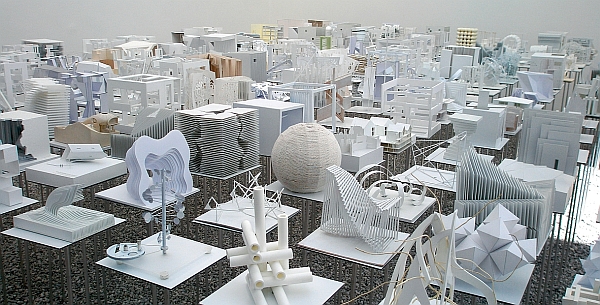Expanding Space
Venice Architectural Biennale 2012
Text and Photos: Eszter G├Čtz
The slogan of this yearŌĆÖs Venice Architectural Biennale by David Chipperfield, the chief trustee (ŌĆ×Common GroundŌĆØ) has turned out to work somewhat peculiarly. It may sound unmeaning if one expects a precisely elaborated concept in the background. The idea of Chipperfield, however, does not construct but destructs ŌĆō with refined means, without hurting but still firm ŌĆō the spectacular star cult built up on the international stage of architecture.
Chipperfield finds the way out of the global architectural crisis in the wake of the economic and social one in the directions of cooperation, openness and the joint formation of the environment culture. The architect asked for help turning to the entire society to find directions for its own future, to learn to express its needs, to think about architectural urban interventions making everyday life easier and more homey. The central pavilion organized the introductions of the invited exhibitions focussing on this idea. We can see here much more traditional architectural model and much less technical virtuosity than usual. Creative teams draw inspiration and gain knowledge from traditional building technologies as well as from ones that do not approach unliveable places from spatial formation but from the aspects of utilization. Such an example is the Gran Horizonte ŌĆō by the Urban-Think Tank group (Alfredo Brillenbourg, Hubert Klumpner) and Justin McGuirk which was awarded the Golden Lion Prize as the best project which developed a new community model in an unfinished dwelling house in Caracas with families living in the neighbourhood and modelled it as a bustling urban hip-place in the space of the Arsenale. This is the point where informal society approaches the official sphere of architecture. But this one is far from being the single experience we gained at the biennale: similarly convincing is the project named Moran Street in which some young architects have shown on a life-size spatial model how to create a half-opened half-private habitat liveable by a community by using recycled materials in an abandoned dwelling house in Detroit. Many of the national pavilions have also pushed communal projects into the foreground. Japanese trustee Toyo Ito in the Japanese pavilion awarded the Golden Lion Prize introduced the architectsŌĆÖ team which built the community centre for a village demolished by the tsunami in 2011 by involving the villagers into every phase of designing. The work processes of Home-for-All are documented step by step on giant posters, models and in subjective blog entries. Visitors going through them sooner or later come to realize and discover the delicate layers of elaborating together the trauma as reflected in the works of the architects. On the ground floor of the highly successful Russian pavilion one can see through a peephole the present-day ruins of the secret scientist-towns of socialism whilst the upper floor ŌĆō almost as a denial of all this ŌĆō presents the i-City, a research centre being built these days. Its data are found in the QR codes covering every room like lace by using the tablets visitors receive at the entrance. The exhibition of the USA, however, hosts ideas of minor communities evolved into projects meant to conjure urban spaces into more liveable ones. The Danish exhibition analyzes the integrity and future of people living in Greenland, their insistence on traditions and the possible explosion-like development of the island in relation with global warming. Kosovo itself leaves the architectural meaning and the assessment of values and quality for the community ŌĆō which here and now equals with the audience ŌĆō: it invites an online public vote for its most recently completed large-scale architectural projects and offers for this purpose entirely subjective emotion-based categories for classification. This year one could discover much more traditional architectural models than usual, and the Hungarian exhibition as such is exactly about it. Trustees B├Īlint Bachmann and Bal├Īzs Mark├│ presented here models by first- and second-grade architect students as several hundreds of snow-white 21×21 cm maquettes. They are not ŌĆō or not exclusively ŌĆō models of buildings, but spatial forms manifested in materials as systems of relations. The concept by the two trustees return to the basics of architecture and thus present how students of architecture ŌĆō architects of the future ŌĆō think about space at the very beginnings of their university studies. More than 500 models are erected here on tall and slender aluminium plinths creating a snow-white forest of forms in each of the three exhibition rooms. At the entrance works by even younger people, teenagers are displayed sharply distinguishing themselves from the rest with their palette. In the centrally positioned patio geometric-organic metal compositions by Antal Kelle counteract the intensity of the vast┬Ā forest of models. The entirety of the exhibition as such is decidedly philosophical as far as its concept is concerned. However, there is no need for an additional explanation. Inside the pavilion the visitorŌĆÖs visual angle is slightly elevated from the ground whilst making a tour of the exhibition on a ramp covered with pebbles on a finely folding ground which rips the observer out of the reality of the present. It is not by chance that architectural journal published every┬Ā day during the biennale stressed the importance of the poetic spatial concept of the Hungarian pavilion in its very first issue. Although the Hungarian exhibition is not spectacular in the present-day sense of the word and does not apply any kind of technological bravura it is a refined addition nicely fitting into the less loud and sensational character of the 2012 biennale paying more attention to processes going on in the depths.

